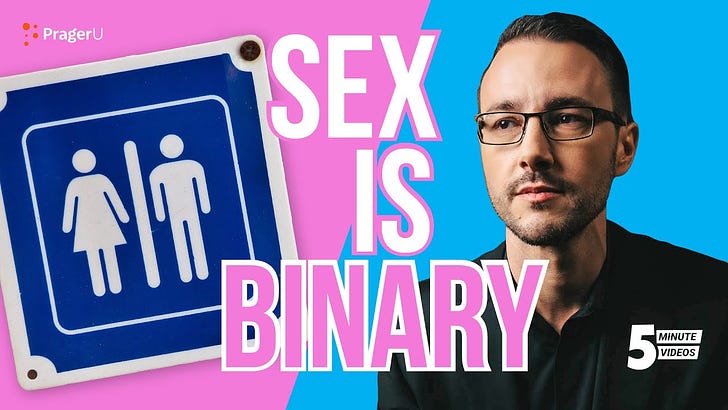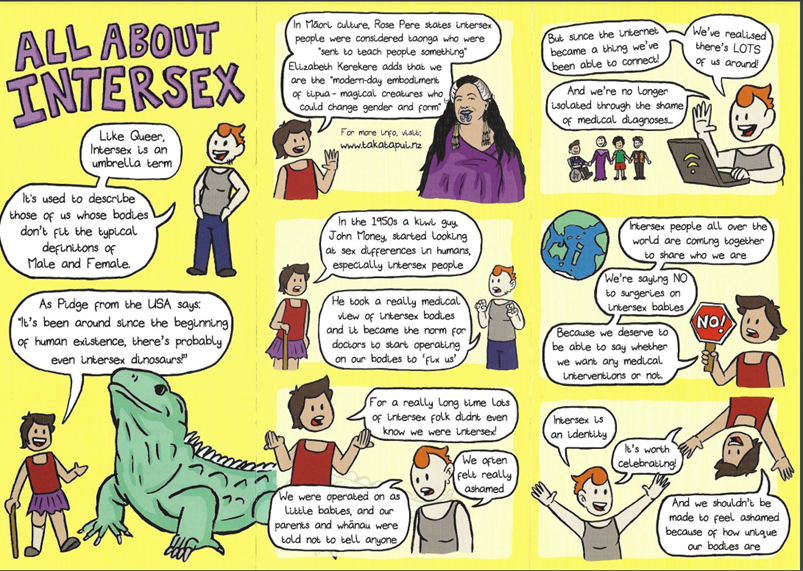LGBTQI is supposed to be a slogan of kindness, acceptance, and unity. But for those co-opted into the acronym against their will, it signifies the opposite.
The acronym represents three disparate groups that have nothing in common:
LGB (lesbian, gay, bisexual) are sexual orientations – not identities.
TQ (transgender, queer) are identities – not sexual orientations
I (intersex) is a medical condition – not a sexual orientation or an identity.
So how did they get linked together into the LGBTQI acronym?
It’s all about the TQ. Those who espouse the belief that there is an inner ‘real me’ hidden beneath the outer version, need something to bolster their claims, since ‘gender identity’ is invisible to science. Intersex has been co-opted to the cause to try to prove that sex is on a spectrum and that trans, queer, and intersex people share the same struggle to claim their true identity.
Intersex is not sex on a spectrum
Whether a person is male or female is the result of a complex interaction of chromosomes, genes, and hormones in utero, and in 99% of cases this intricate process works correctly and humans can be accurately classified as male or female in the first trimester of pregnancy.
Sex is a classification of a person’s reproductive capacity – whether their bodies have the capacity to produce sperm or ova. As there are only these two ways of contributing to reproduction, and no humans can produce both sperm and ova, there are only two sexes. This 5-minute video from evolutionary biologist, Colin Wright, provides a clear explanation:
Intersex, or DSD (differences in sexual development), is a medical condition that presents in dozens of different ways. However, most people who have DSD can be readily classified as male or female, with chromosomal abnormalities, and are not a hybrid mixture of sexes.
Claims that 1.7% of people are intersex (the same as the incidence of red hair) have been inflated by including in the count those with conditions such as Klinefelter (XXY - male) or Turner (X0 - female) syndromes. To retain its proper meaning, the DSD label should be restricted to those conditions where chromosomes and genitalia are inconsistent and not classifiable as male or female. Using that criteria, the prevalence of DSD is about 0.018%, or 1 in 5500 people.
In the past, it was thought that the best course of action for babies born with ambiguous genitalia was to “assign” them a sex and provide corrective surgery as soon as possible. Now, the usual practice is not to undertake any unnecessary surgery until the child can be involved in the decision. To legitimise their claims, the TQ lobby have appropriated this medical process and ridiculously assert that everyone is “assigned a sex at birth”.
Do five-year-olds need to know about intersex?
According to Family Planning they do. [Family Planning has just changed its name to “Sexual Wellbeing Aotearoa” – SWA]
In its Navigating the Journey lesson plans, after teaching 5-7 year olds the correct names for genitals, teachers are scripted to say, “Some people’s bodies don’t have typical “boy” or “girl” parts and that is OK.” Having just learned the correct name for a penis, young children are immediately given the very confusing message that someone with a penis might be a girl. “Encourage students to recognise that some peoples’ biological sex is different to their gender identity. For example, someone born with a penis may identify as a girl.” (p52 NTJ, Y1-2)
SWA instructs teachers that, “Some people are born with body parts that are not completely male or female. This is called “intersex”. The differences may be inside or outside of their bodies, or both. People who are intersex identify across the gender spectrum, and some may identify outside of male or female definitions.” (p51 NTJ, Y1-2)
As only 1 in 5500 people has a DSD, and most children will never encounter it, this is something that young children do not need to learn. Intersex conditions are very complex, and simplistic reference to them alongside the false concept of everyone having a gender identity independent of their sex, are not appropriate topics for very young children.
Co-opting intersex (and Māori culture) to bolster transgenderism
Even though DSD affects so few people, schools are using this medical condition to incorrectly claim there are three sexes and to teach gender identity ideology.
The deceptive ideas are repeated at every year level, until at Y7-8 students are taught:
“Sex” refers to the biological sex assigned at birth. For example, female, male and intersex. Intersex is used for people who are born with body parts that are not completely female or male. The differences may be inside or outside of their bodies, or both. People who are intersex identify across the gender spectrum, and some may identify outside of female or male definitions. It is important to be aware that at least 1 in 2,000 people are intersex. All bodies need to be acknowledged and celebrated. (p30 NTJ, Y7-8)
Being transgender is deliberately attached to intersex to make the desire to change sex appear ‘natural’:
“Your students may have friends or whānau who are transgender, or intersex, or they could be transgender or intersex themselves. Ensure that you develop an inclusive classroom culture where diverse identities are acknowledged, valued, and respected. Explain that some people have a mix of female and male genitals, hormones, or chromosomes. The term for this is “intersex”. Other people may be born with female or male bodies, but as they grow up, they identify as being of the opposite gender, or of neither gender. The term for this is “transgender” or “non-binary”. (p33 NTJ, Y7-8)
Students are referred to a brochure from Intersex Youth Aotearoa that claims that, intersex is an identity and that in Maori culture, “intersex people were considered taonga who were ‘sent to teach people something’”. (Never mind that many DSD conditions are not visible externally and are not identifiable without modern technology.)
The real world impact
Teaching children that sex is on a spectrum and is a matter of choice has a negative impact on those children who do have DSD. Here is what one mother reports:
“I am raising an intersex child. My child is a girl, she was a girl before the testing revealed her genes, and she continues to be a girl. She is Intersex but also Female*.
My daughter asked me once why people would choose to be different. She doesn't have a choice and doesn't understand why anyone would want what she has to deal with - including the ridicule and nasty comments people make.
It is children like mine who are vulnerable to Gender Ideology. My child has been compared to a trans child, as though her genetics are a choice, she was born in the wrong body, and she is able to choose which gender she is. She has been told she is neither and both genders and that her brain is able to think as either a boy or a girl. People telling her what she should feel/believe/be.
This is a medical condition that leaves you feeling isolated and distrusting of the general public. What have the teachers been taught about Intersex conditions? Are there doctors writing that part of the curriculum?
The trans comments some students make are because she chooses to wear grey trousers instead of the kilt. She gets cold easily which is a seizure trigger. It's a valid option, but only 3 or 4 girls choose trousers in the whole school (nearly 2000).
Ironically the only time she has questioned being a girl has been during Gender Equality lessons this year - where they explored arranged marriages, low incomes, and limited educational opportunities for women. After a lesson like that, who would want to be a girl? We removed her from that class and she isn't continuing in RSE.
These gender policies are hurting the kids who are genuinely different, turning it into a trend and/or attention seeking activities. Kids that were carried up in the hype and promise of being accepted if you act a certain way or believe a certain thing are finding out that it won't make them happy. These kids need help, they need to talk to their parents/guardians, talk to a counsellor that won't echo back at them that being non-binary or trans is the only answer. Teenagers are going through a lot of changes and this is the time they most need us parents.
*The girl in this testimony has Swyer Syndrome. She has XY chromosomes, normally functioning vagina, uterus, and fallopian tubes, but no ovaries or testes.
Ask your children
Navigating the Journey is used in about 30% of NZ schools. Some teachers will use the lesson plans exactly as they are presented and some will pick out and use only selected parts. As the information about DSD / intersex is often delivered orally, you will need to ask your children to find out what they are being taught about sex and DSD.
If you find the school is teaching about DSD, write to the Principal to point out:
DSD is so rare it is not relevant for children to learn about it.
DSD is not a third sex.
Gender identity is a belief in an invisible internal feeling which has no scientific backing whatsoever.
Teaching children that sex is an unstable state and something they can choose is a recipe for creating anxiety and other psychological harm.







It is the transgender movement that has made intersex into something strange. In the past intersex people just got on with their lives.
I used to teach about Intersex in the School of Medical Sciences at UNSW. It's a chromosomal abnormality impacting around 0.04% of the population. They have been kidnapped and held hostage by the TQA mob (who seem to run the whole LGBTQA hive mind) simply to add cred to the rainbow alliance. Intersex doesn't want any part of the rainbow and never did. They just want to get on with their lives. Their inclusion is a disgrace.